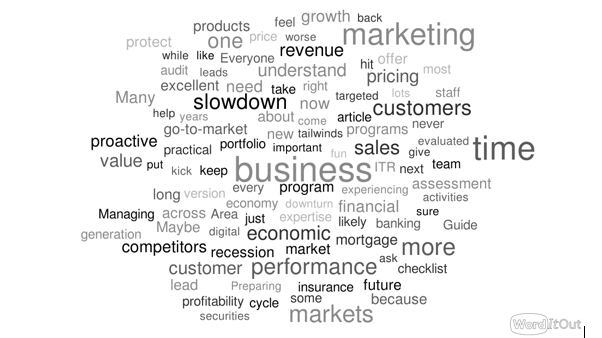When the Economy Turns Down, Will Your Company Be Ready? A 10-Step Practical Guide to Preparing Your Go-to-Market Program

John C. Maxwell, the American author, speaker, and pastor who has written many books on leadership has a wonderful quote about growth that says: “Change is inevitable, growth is optional.” There may be another version of this we should be paying attention to, and I think that version is: “Change is inevitable, so is an economic slowdown.”
With the long economic growth we have been experiencing sometimes it’s challenging to remember that we will not always have the economic tailwinds that have been boosting us along. The most recent ITR Trends Report (April, 2019) continues to forecast a cyclical market slowdown. Their latest report states that “The U.S. economy has moved a little deeper on the backside of the business cycle….and the shift in momentum and outcome will feel more pronounced the further we go in 2019. Our analysis continues to point to a probable first-half-2020 bottom for this business cycle.”
The ITR analysts also advise contingency planning in case the cycle downturn is worse than projected, and advise business executives to “not to forget to play offense by devising tactics to beat the business cycle as best you can over the next four to six quarters.”
The timing and severity of economic slowdowns may be a moving target—maybe we are already experiencing it, maybe not. Maybe the next one will have a steeper decline than originally thought, maybe it will be a gentle decline. That’s not my point.
There will be an economic slowdown, and just as ITR recommends, it’s time to be proactive and to play offense. What does that mean to your business and your go-to-market programs?
Preparing Your Business and Go-to-Market Program NOW is Important
In most companies, surviving or even thriving, in an economic downturn is possible. Can you grow in a declining market? Of course you can, that’s why you get paid the big bucks.
When the financial recession hit in 2007-2009, I was managing a team of financial compliance experts serving the banking, securities, insurance, and mortgage markets. No one expected the recession to hit so quickly, or to have such a large impact on the financial markets. We lost over 300 mortgage originator customers in 30 days—gone, poof. Never to come back.
We decided that now was the time to demonstrate our management expertise, and took proactive, offensive actions to not only survive the recession but to come out as a stronger player when the economy came back with healthy tailwinds.
That’s important context, because you can either put your head in the sand or you can take the initiative. We took the initiative. Here’s what we did, and I’ll offer these 10 steps as a practical, proven approach.
The Ten-Step Checklist
- Protect every customer relationship you have. In a slowdown, there will be fewer new business start-ups, less capital to invest, and lots of hunkering down. You have invested time and resources acquiring your customer portfolio. Protect every one of those relationships. Understand which customers are worth the most to you (revenue, contribution, customer lifetime value), and make especially sure you protect the highest value customers through your servicing touchpoints.
- Keep competitors at bay—lock them out for a long time if you can. Everyone is going to be looking for revenue, and your competitors may be more aggressive with pricing in order to try to stay viable. If you offer subscriptions, one proactive tactic is to offer multi-year subscriptions with price protection built in. We did this successfully, extending every one-year subscription to two or three years and locking in the price for our customers. We now had predictable revenues for several years, and our competitors were locked out. Many competitors never survived. If you sell products, you can protect your revenue streams, too. One way to consider involves leasing your products versus one-time sales. Here’s an excellent article on the options.
- Go deep on innovation. This might sound crazy, but when markets are in turmoil, it’s a wonderful opportunity to have a conversation with your customers about their pain points and to work collaboratively with them to reengineer business processes and to understand where digital tools could improve process cycles, costs, and quality.
Many competitors will be cutting their R&D and product development budgets. You'll be cautiously investing in new solutions. When the slowdown ends, they will be in worse shape and you’ll likely have something new to offer the market. There’s a common phrase “never kick someone when they are down.” There’s a version of that phrase in Italy that says “the best time to kick someone is when they are down (because that’s when you have the greatest advantage), but not if they are a relative or they have lots of friends.” As an Italian, I kind of like that approach.
- Take the opportunity to understand where your business makes money. A slowdown should force you to take a deeper look at your business. I’ve found that market, customer, and competitor insights are often not a strength of many businesses. Many of my clients have been in markets for a long time, but when you ask questions about share, profitability across multiple markets, profitability across customers and competitor knowledge, you get a lot of blank stares. You should improve your business intelligence now to re-shape your focus and priorities, and to prune unprofitable parts of your business.
Another great place to focus is on your product and service portfolio. If you haven’t evaluated the performance of your products across your entire portfolio for a while, this is an excellent time to understand their role in your offering, their profitability, and expectations for future growth and contribution. Slowdowns give you a fresh set of eyes to understand what drives your business. Understand, validate, then act with confidence. This is no time to keep unprofitable business around.
- Diversify markets and customers. One of the reasons we were able to grow our business 8% annually through the financial recession of 2007-2009 was our revenue mix. Serving several markets (banking, securities, insurance, and mortgage), meant that while some markets were hit hard (mortgage), others were impacted to a much lesser degree (banking, insurance). Now is the time to reduce your business concentration risks from too few markets and from a small number of large customers.
- Stop shot-gunning lead generation and get more targeted. If you are using passive lead generation programs as your primary source of new business, it’s time to get more focused and targeted. Websites alone will not drive enough qualified leads for your sales group to live on. You’ll need to using proactive lead generation tactics like paid search, and account-based marketing to help you more efficiently put more qualified leads into your sales pipeline. If you want to learn more, check out this article.
- Complete a Marketing Assessment and Audit. If you have not done a rigorous review of the performance of your marketing programs, it’s time. The goals of a marketing assessment and audit are threefold:
- Provide an immediate identification of “Horizon 0” opportunities which can be evaluated for immediate performance and financial improvement. You can learn more here.
- Set a formal baseline of current performance which will function as a foundation for future performance improvements.
- Ensure that marketing performance aligns with future needs by quantifying the gap between current and required future performance.
The value of this analysis is to capture key go-to-market and operational insights to allow clients to design and implement winning strategies.
The marketing assessment and audit evaluates 26 marketing capabilities across four dimensions of performance: cost, revenue creation, time-to-market, and competitiveness. Each capability is scored and a highly graphical heat map highlights areas of greatest need. The assessment generates implications and recommendations which must be accounted for in a strategic marketing plan.
- Evaluate the performance of your Marketing and Sales staff and suppliers. You’ll need high value from everyone on the team, internal as well as external. Time to check whether you have the right number of Marketing and Sales people in the right seats and with the right skills. Have you waited too long to implement a more proactive digital marketing program because you don’t have the internal expertise? Maybe time for a swap out or an addition. Are your suppliers bringing maximum value to you? Time to ask them to buy-in with extras (research, services, etc.).
- Fine-tune your pricing. Just as I’ve recommended for fine-tuning your markets, customer relationships and products, this is an excellent time to review your pricing strategies and tactical execution. Have you deployed a consistent pricing strategy? If so, what is it? How consistently is it utilized? Where are you losing value because your prices are too low?
If you need help in this area, I’d recommend an excellent eBook from Bob Sherlock, one of my colleagues. Bob shared his expertise in Daring Caution, An Executive’s Guide to Pricing Improvement. This is a thorough and also practical guide to pricing. You’ll recoup the $19.95 price of this book in minutes.
- Empower and develop your Marketing and Sales staff, and have some fun, too. Everyone will likely feel the effects of a slowdown in different ways. It’s your job to keep them aligned, focused, and acting as a team. Schedule some fun team-building activities. Make sure your staff have the ability to act on each one of the previous nine checklist ideas, too. They need to feel empowered and part of the solution.
What Next?
A wise person reading this article and the 10-step checklist may likely say: “Why shouldn’t I be doing these activities all the time and not just to prepare for an economic slowdown?” You get an “A.”
Having challenges with your pipeline management, alignment of sales and marketing programs, customer acquisition, cost per lead, or overall revenue growth? If you are interested in learning more about building a high-performing Marketing program, please give me a shout.

Topics: Business Growth Strategy, Business Planning, CEO Business Strategy
Thu, May 9, 2019Featured Chief Outsider
The Chief Outsider
Related Articles

.png?width=1500&height=398&name=CO_Corporate%20Logo%202021_4C_HOR_FNL-1%20(1).png)
